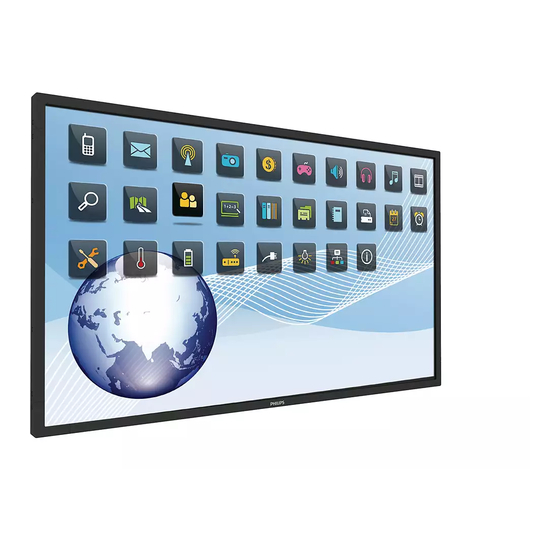Philips Signage Solutions BDL6526QT Podręcznik użytkownika - Strona 29
Przeglądaj online lub pobierz pdf Podręcznik użytkownika dla Monitor Philips Signage Solutions BDL6526QT. Philips Signage Solutions BDL6526QT 43 stron.

BDL6526QT
Scan mode
When viewing content from a connected game console, choose {Game}
to apply game settings. When a computer is connected through HDMI,
choose {Computer}.
Make sure that {Format and edges} {Picture format} {Unscaled}
is selected so as to view maximum detail.
Format and edges
• {Picture format}: Change the picture format.
See page 15 for the descriptions about
Picture reset
Reset all your picture settings to the factory defaults.
5.1.2. Sound
Picture
Sound style
Sound
Bass
Tiling
Treble
Network
Balance
General settings
Volume
Minimum volume
Maximum volume
Surround mode
Audio out (line out)
Advanced
Card OPS audio
Sound style
Access predefined sound settings.
Bass
Adjust to increase or decrease lower-pitched sounds.
Treble
Adjust to increase or decrease higher-pitched sounds.
Balance
Adjust to emphasize left or right audio output balance.
Volume
Adjust to increase or decrease the volume.
Minimum volume
Set the Minimum volume.
Maximum volume
Set the Maximum volume.
Surround mode
Enhance your audio experience.
Audio out
Adjust audio output volume.
Advanced
Access advanced settings to enhance your audio experience.
• {Auto volume leveling}: Enable the reduction of sudden volume
changes.
• {Speaker settings}: Turn on or off the internal speakers.
• {Clear sound}: Enhance sound quality.
• {Audio out format}: Choose the type of audio output through
the digital audio output connector. (HDMI only)
Picture format
.
• {Audio out delay}: Automatically sync the image on this display
to the audio from a connected home theatre.
• {Audio out offset}: Adjust the setting for audio output delay.
Available if {Audio out delay} is switched on.
Card OPS audio
Choose to set OPS audio output format.
The options are: {Auto}, {Analog}, {Digital}
5.1.3. Tiling
Picture
Sound
Tiling
Network
General settings
With this function you can create a single large-screen matrix (video
wall) that consists of up to 100 sets of this display (up to 10-sets on the
vertical and 10-sets on the horizontal sides). This function requires one
or more daisy-chain connections.
Enable
Choose to {On} or {Off} the Tiling function. If {On}, the display will
apply the settings in {H monitors}, {V monitors}, {Position}, and
{Frame comp.}.
H monitors
Adjust displays on the horizontal side.
V monitors
Adjust displays on the vertical side.
Position
Adjust the position of this display in the screen matrix.
Example: 2 x 2 screen matrix (4 displays)
H monitors = 2 displays
V monitors = 2 displays
1
3
20
Enable
H monitors
V monitors
Position
Frame comp.
Switch on delay
H monitors
2
4
Position
